Effective Strategies for DIY Termite Elimination
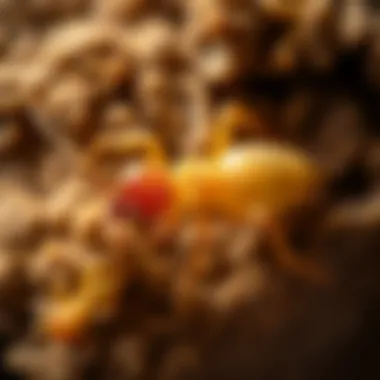
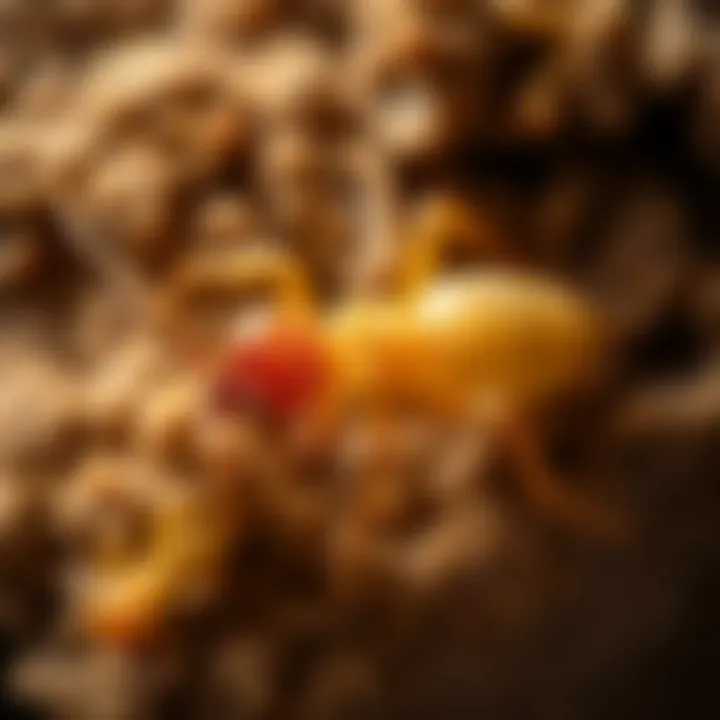
Intro
Termites can be a homeowner's worst nightmare. These tiny insects can wreak havoc on your property in a remarkably short period. Understanding how to identify, prevent, and treat termite infestations is crucial for anyone looking to maintain their home in top shape. This guide delves into effective strategies for do-it-yourself termite elimination, equipping you with the know-how to tackle this issue head-on. We’ll discuss how to recognize the telltale signs of these wood-destroying pests, implement preventive measures, and explore treatment options. In short, this article aims to empower you to take control of your environment.
Pest Identification
Identifying termites is the first step in managing these pests effectively. There are several species of termites, but the most common ones found in homes include the Subterranean, Drywood, and Formosan termites.
Detailed Descriptions of Common Pests
- Subterranean Termites: These are usually found underground and are known to create extensive colonies. They often invade homes from the soil and are particularly attracted to damp environments.
- Drywood Termites: Unlike their subterranean cousins, drywood termites infest wood directly and can live inside it without contact with the ground. They are common in drier climates and leave behind fecal pellets.
- Formosan Termites: Particularly aggressive, Formosan termites create large colonies and are known to cause significant damage rapidly. They can establish themselves in a variety of environments, making them a serious threat.
Signs and Symptoms of Infestations
Recognizing the signs of termite activity can save you from extensive damage. Look out for:
- Mud Tubes: These pencil-sized tubes are often found along walls and foundations — a telltale sign of subterranean termites.
- Swarmers: If you see winged insects during spring, it may indicate a colony is nearby. Many take to the air, seeking to establish new colonies.
- Wood Damage: Hollow-sounding wood or trails left in wooden structures can suggest drywood or subterranean termite activity.
- Fecal Pellets: Drywood termites often leave behind small, oval-shaped feces, giving clues about their presence.
"Early detection is the key; don’t wait for obvious damage to show. Look for the signs!"
Recognizing these signs makes a significant difference, setting the stage for timely intervention and management.
Prevention Strategies
Stopping termites before they become a problem is easier than curing an infestation. Prevention is often the best strategy.
Home Maintenance Tips for Pest Prevention
- Seal Cracks: Regularly check for cracks in your foundation, walls, and around windows. Sealing these becomes a barrier for termite entry.
- Proper Drainage: Ensure that water drains away from your home’s foundation. Stagnant water can create a perfect breeding ground for termites.
- Reduce Moisture: Keep humidity low in your home, especially in areas like basements and attics, to discourage termite attraction.
- Wood Storage: Store firewood and lumber away from the house and off the ground to minimize risk.
Natural Deterrents and Barriers
Implementing natural barriers can greatly reduce termite risks:
- Cedar Mulch: This can deter termites effectively due to its natural compounds.
- Nematodes: These microscopic worms are a natural predator of termites and can be introduced to your garden.
- Borates: Using borate-treated wood can help prevent termite infestations effectively.
Utilizing these preventive measures can help maintain a termite-free environment while saving you from future headaches.
Treatment Options
When faced with an infestation, understanding your treatment options allows you to act quickly and efficiently.
Overview of Chemical vs. Natural Treatments
- Chemical Treatments: Products like liquid termiticides can be effective in killing termites and preventing future infestations. However, proper application is crucial for effectiveness and safety.
- Natural Treatments: Options such as diatomaceous earth and essential oils can also provide a level of defense, appealing to those who prefer eco-friendly solutions.
Step-by-Step Guides for DIY Treatments
- Prepare Your Space: Clear out any obstacles around the infested area for easy access.
- Choose Your Treatment: Depending on the severity of the infestation, decide between chemical or natural treatments that suit your needs.
- Application: For chemical treatments, follow the instructions carefully. For natural methods like diatomaceous earth, apply generously around the affected areas.
- Monitor: After treatment, keep an eye out for any signs of continued activity. Try to stay vigilant!
- Repeat as Necessary: Some treatments may require reapplication for lasting results.
In most cases, observing a few months of adequate treatment will help you determine if the problem is under control.
Understanding Termites
Understanding termites is the cornerstone of any effective strategy for their elimination. These insidious pests can quietly wreak havoc on homes, and their ability to go unnoticed for long periods makes it crucial for homeowners to have a solid grasp of their biology, behavior, and signs of infestation.
The Biology of Termites
Termites are more than just destructive insects; they’re fascinating creatures with complex social structures. Belonging to the order Isoptera, these insects are often found in colonies that can number in the thousands. Structurally, their body consists of three segments: the head, thorax, and abdomen. This division supports their various functions—eating, reproducing, and eventually causing damage. Some key biological points include:
- Digestive system: A unique aspect of termites is their ability to digest cellulose, thanks to symbiotic microorganisms in their gut. This trait allows them to feed on wood and plant materials that many other animals can’t utilize.
- Reproductive class: The queen's role is critical; she can lay thousands of eggs daily, ensuring the rapid growth of the colony.
- Castes: Termite colonies typically consist of three castes - workers, soldiers, and reproductives. Each caste performs specialized tasks which help the colony function effectively.
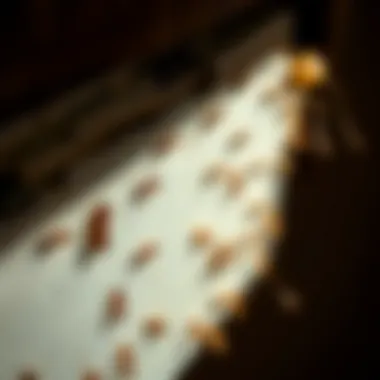
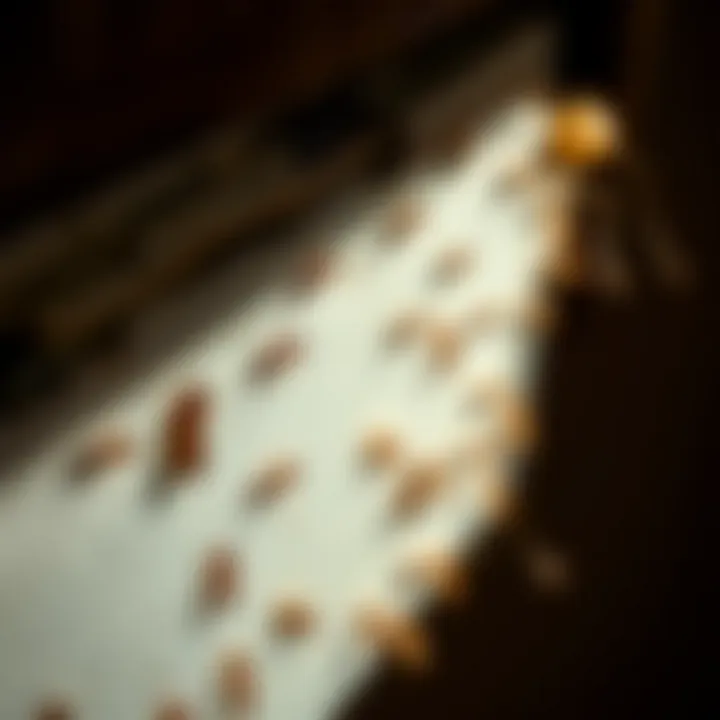
Understanding the biology of termites helps in identifying vulnerabilities that can be exploited for effective elimination.
Common Types of Termites
There are several species of termites, and knowing the difference can help tailor specific strategies for elimination. Here are the most common types:
- Subterranean termites: They live underground and build colonies in the soil, often infiltrating structures from below. Their presence is widespread across many regions, making them a primary threat to homes.
- Drywood termites: These termites infest the wood they consume, making their presence difficult to notice until significant damage is done. They do not require contact with soil, which allows them to survive in wooden structures.
- Dampwood termites: Primarily found in regions with high humidity, they infest moist wood. This can include decaying trees and structural elements that have become wet over time.
Recognizing which type of termite you are dealing with can significantly impact the effectiveness of the elimination strategy chosen.
Signs of Infestation
Recognizing the signs of a termite infestation is crucial. The sooner an infestation is identified, the more effective and less costly the removal efforts will be. Look for these indicators in your home:
- Mud tubes: Subterranean termites build these to travel between their colony and food sources. They look like small, dirt-colored tunnels and are often found on walls, foundations, or beams.
- Wood damage: Check for hollow-sounding wood or damaged structural components. If knocking on wood gives a dull sound rather than a solid one, termites may be at work.
- Discarded wings: After swarming, termites shed their wings. Finding clusters of these wings near windows or doors may indicate an infestation nearby.
"It’s often the small signs that lead to finding the bigger problems. Staying vigilant can save your home from significant damage."
- Droppings: Termite feces can look like small pellets, often found near wood they’ve infested. Different types of termites produce different droppings, adding another layer to identification.
By remaining alert to these signs, homeowners can act swiftly, preventing extensive damage that can come at a hefty price.
Identifying Termite Infestations
Understanding how to identify termite infestations is crucial for any homeowner. Termites can cause significant damage to the structure of your home, and catching them early can save you a considerable amount of money and stress. Knowledge of their behavior and signs of presence helps in taking preventative and corrective measures effectively. Let's delve deeper into the different methods for spotting these unwelcome pests before they wreak havoc.
Visual Inspections
One of the first lines of defense in identifying termite infestations is through visual inspections. Start by thoroughly examining areas where wood meets soil, such as the foundation, basements, crawl spaces, and around wooden decks. Look for signs like mud tubes, which are about the thickness of a pencil and provide shelter for termites as they travel between their colony and food sources. If you spot any swollen or blistered wood, tap on it gently. If it sounds hollow, that could be a direct indication of termite damage.
- Key places for inspection:
- Foundation walls
- Near plumbing leaks or moisture problems
- Wooden beams and posts
- Areas with poor ventilation
Besides obvious signs, don’t forget to check your attic and other less frequent areas. Termites can be tricky and they often hide in places that are not immediately visible. Regular inspections can keep these enemies at bay.
Sound Analysis
While inspecting visually is effective, sometimes you need to hone in on your hearing. Termites, particularly drywood termites, can be detected by their eating habits. Listen closely for sounds that could be indicative of termite activity. Some homeowners report a faint clicking noise from wooden structures, which is caused by termites themselves as they eat or communicate with each other.
If you suspect termite activity based on sound, take action with swift visual verification. Remember, this method requires patience and a keen ear; if you hear something unusual, investigate further.
Tracking Methods
Another method to identify an infestation is through tracking and monitoring. This involves using bait and monitoring stations to keep an eye on potential termite activity over a period of time. These bait stations contain materials that attract termites, allowing you to see if they're present in your home.
- Steps for effective tracking:
- Place bait stations around suspected entry points or areas with visible wood.
- Check stations regularly for signs of termite presence, such as wood pellets or damaged bait material.
- Document findings, which can be helpful if you ever need to call in a professional.
Using these methods, you can not only identify if termites are present but also gauge the level of activity. The more evidence you gather, the better you'll understand the situation — and the sooner you'll be able to take action.
Regular checks and early detection are your best bet to avoid serious termite damage. Don't wait until it’s too late.
With thorough inspections, a keen ear, and monitoring methods, homeowners can gain confidence in their ability to spot termite infestations. Prompt identification is a significant step in protecting your home from these wood-destroying pests.
DIY Elimination Techniques
When faced with a termite invasion, many homeowners ponder if they should reach for the phone to call in the pros or roll up their sleeves for some good ol' DIY elimination techniques. This section shines a light on the myriad approaches available to effectively tackle termites yourself. Understand that the advantage of DIY is twofold: saving money and engaging with your home’s maintenance in a hands-on way. However, it's pivitol to weigh the benefits against the need for safety and thoroughness in applying these strategies.
Boric Acid Applications


Boric acid is a tried-and-true method for exterminating termites, and it's often touted for its effectiveness and relative safety. When applied correctly, this powder can disrupt termite digestive systems, leading to their demise. Mixing boric acid with sugar, for instance, creates an attractant bait. Terimtes are lured in, consume the mix, and suffer the consequences shortly after. This method is particularly efficient in areas where you may suspect termite activity, and perhaps doesn’t require high-tech gear or special licenses.
Steps for Implementation:
- Identify spots of high activity in your home using signs such as mud tubes or hollowed out wood.
- Create your boric acid and sugar bait mixture. A good rule of thumb is to use a 20:80 ratio of boric acid to sugar.
- Apply the mixture in areas like attics, basements or near any wooden structures, ensuring it is out of reach of pets and children.
"Patience is key; it may take time before you notice any significant changes as termites communicate and share the bait with each other."
Using Diatomaceous Earth
Diatomaceous earth presents another DIY solution that’s both natural and effective for combating termites. Made from crushed fossilized algae, this powder acts as an abrasive substance. When termites come in contact with it, they become dehydrated and ultimately die off. Moreover, it is non-toxic to humans and pets, making it a safe choice for homeowners wary of chemicals.
How to Use Diatomaceous Earth:
- Carefully apply a layer of diatomaceous earth in identified hot spots or around potential entry points.
- Ensure even coverage, but take care not to apply it where water could wash it away.
- Reapply after any rain or if it gets disturbed.
Homemade Traps
Creating traps at home, while straightforward, can also be particularly effective in getting rid of termites. The concept is simple—you’re trying to outsmart them by using their own seeking behavior against them.
A great go-to trap is to use cardboard, which termites find irresistible. When the cellulose in cardboard gets moist, the termites will come flocking.
- Take several pieces of cardboard and wet them slightly to make them attractive.
- Stack these cardboard pieces in the areas where you suspect termite activity.
- After a few days, you can collect the infested cardboard and burn or discard it securely.
Liquid Insecticides
Liquid insecticides provide a more aggressive approach to dive deeper into termite infestations. With numerous types available, it's key to select formulations specifically designed for termite control. While the application requires some care, they often act faster than baits in killing active termites.
Application Tips:
- Always read the manufacturer's instructions before use to apply safely and effectively.
- Focus on areas where signs of activity were noted.
- You can use a garden sprayer or a paintbrush for application, allowing you to target greater precision in tricky spots like walls and foundations.
In summary, the DIY techniques for termite elimination provide a cost-effective and empowering route for homeowners. With diligence and the right materials, it’s possible to reclaim your space from these pesky invaders, all while enhancing your home knowledge and maintenance skills.
Chemical Solutions for Termite Control
Addressing termite infestations in your home can feel like an uphill battle. Yet, chemical solutions play a crucial role in any effective termite control strategy. This section will delve into the specifics of how these chemicals work, highlight the benefits they offer, and discuss important considerations when using them. By understanding these components, homeowners can make informed decisions and take significant steps towards safeguarding their properties.
Understanding Termiticides
Termiticides are chemical agents designed specifically to repel or kill termites. They come in various formulations, ranging from liquid to granular and foam types. Knowing the right product can mean the difference between a successful eradication and another failed attempt at controlling these pests.
For many, the challenge lies in choosing between pre-construction and post-construction termiticides. Pre-construction products are often utilized during the building phase to create a barrier, effectively preventing termite infiltration. Post-construction options, however, offer a way to tackle existing infestations.
- Types of Termiticides:
- Liquid Termiticides: Create a chemical barrier in the soil.
- Bait Systems: Involve using attractants mixed with toxicants that termites bring back to their colonies.
- Foam Termiticides: Can penetrate small cracks and voids, making them useful in treating structural wood and hard-to-reach areas.
This understanding of termiticides allows you to tailor your approach according to your specific needs.
Application Techniques
Applying termiticides effectively is critical in ensuring they do their job well. Firstly, read the instructions carefully on the product label. Many products guide you in terms of the quantity required and the areas to target.
Here are some common application techniques:
- Trenching: Involves digging a trench around the foundation of your home and filling it with liquid termiticides. This creates a barrier to prevent termite access.
- Injection: Use pressurized equipment to inject termiticides directly into wood or areas where termites are likely to be hiding. This is particularly useful for targeting active infestations.
- Baiting systems: These can be installed in the ground around your home. Regular checks are essential to keep track of any activity and to replenish bait as needed.
By mastering these techniques, you’ll maximize the effectiveness of your chosen termiticides.
Safety Considerations
While termite control is vital, safety should never be sidelined. Chemical solutions, although effective, can pose risks to both humans and pets if not handled correctly. Here are some key points to keep in mind:
- Protective Gear: Always wear gloves, masks, and eye protection when applying termiticides. This minimizes direct exposure and keeps you out of harm's way.
- Ventilation: Ensure that the area is well-ventilated when working with chemicals indoors. This reduces the risk of inhalation and helps disperse fumes.
- Storage: Store any unused chemicals in a secure location out of the reach of children and pets. It's critical to follow disposal guidelines, as improper disposal can have harmful environmental impacts.
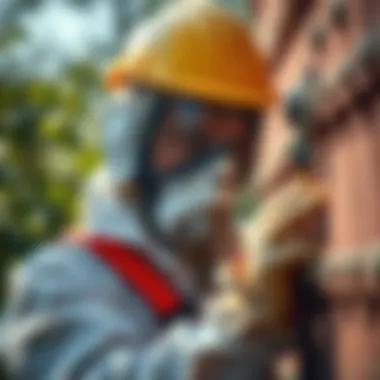
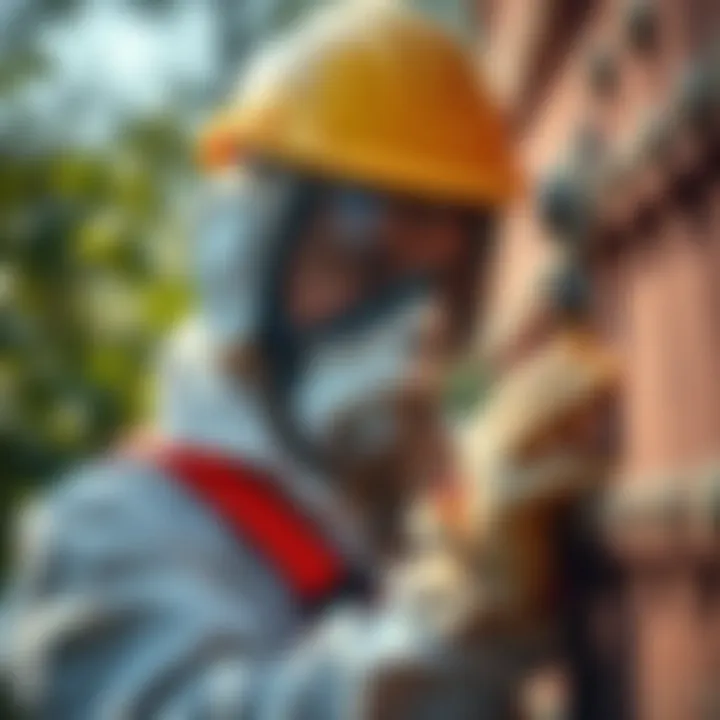
Remember, even though you are taking on the DIY approach, respecting the potency of these chemicals is paramount for both effectiveness and safety.
In summary, chemical solutions constitute a powerful asset in battling termite infestations when employed with understanding and care. Equip yourself with knowledge about termiticides, implement proper application techniques, and focus on safety precautions to ensure a comprehensive termite control strategy.
Preventive Measures Against Termites
Preventing a termite invasion is akin to locking the barn door after the horse has bolted. It’s not just wise; it’s essential. This section sheds light on how proactive measures can shield your home from these pesky pests. The costs associated with termite damage can skyrocket, so taking action early is always a prudent idea. By implementing a few straightforward strategies, homeowners can significantly diminish the risk of infestation.
Maintaining Home Dryness
One of the leading things termites love is moisture. A damp environment sets the stage for them to thrive. It’s like inviting them over for a tea party! Keeping your home dry is a non-negotiable when it comes to prevention.
- Fix Leaks: Start by checking for and repairing any leaks in plumbing or the roof. The trickling water may attract termites, turning your lovely abode into a termite buffet.
- Ensure Proper Drainage: All water should flow away from the foundation. Make sure gutters are clean and downspouts direct water away from your house. If not, consider installing extensions to do the job right.
- Ventilation is Key: Don’t underestimate the power of good ventilation in places like your basement and crawlspace. Installing vents can help maintain lower humidity levels, deterring unwanted guests.
Proper Landscaping Techniques
Landscaping can be a double-edged sword in the fight against termites. While well-placed shrubs and trees enhance your home’s curb appeal, improper practices can invite trouble.
- Distance Matters: Ensure wooden mulch is not piled near your foundation. If termites get the idea that the mulch is a cozy place to hang out, they’ll take the short trip to your home. Keep it at least eighteen inches away from your foundation.
- Trim Trees and Bushes: Make sure that no tree branches or shrubs touch the structure of your home. These can act as bridges for termites to access your walls.
- Diverse Planting: Instead of planting too many wood-based landscaping materials, consider using rock or stone in your garden. They’re less inviting to termites.
Regular Inspections
Much like going to the doctor for regular check-ups, regular inspections at home can save you from larger headaches down the line. Catching termite activity early leads to a better chance of successful elimination.
- Visual Assessments: Every couple of months, take a thorough look around your home, especially in hidden areas like basements, crawl spaces, and attics. Look for signs like mud tubes, droppings, or any wood damage.
- Hire a Professional Every Year: While DIY inspections are great, enlisting a professional pest control service for an annual inspection can provide peace of mind. They have that experienced eye to catch issues you might miss.
- Utilize Technology: Consider gadgets like moisture meters or infrared cameras. They can help identify hidden infestations by detecting moisture and abnormal temperature patterns around your home.
"An ounce of prevention is worth a pound of cure"; investing time in these preventive measures might just save your home from a world of hurt. The more proactive you are, the less chance you have for an infestation taking root.
By focusing on these preventive measures, homeowners can outsmart termites before they have a chance to set foot in their homes. Keep your home dry, mindful of landscaping, and maintain a schedule for inspections to keep these relentless pests at bay.
When to Seek Professional Help
Understanding when to call in the big guns is vital when dealing with termite infestations. While there are numerous do-it-yourself strategies that homeowners can employ, certain scenarios warrant contacting a professional. Not only can this decision save you time and effort, but it can also protect your property from further damage.
Assessing Severity of Infestation
Before you decide to reach out for professional assistance, you must assess the severity of the infestation on your premises. Here are some signs that can indicate it’s time to call in an expert:
- Extensive Damage: If you notice significant structural damage, such as sagging floors or walls, it’s a strong cue that the problem may have escalated beyond casual control methods.
- Active Termites: Spotting live termites during the day is definitely concerning. If you observe swarms or mud tubes on exterior walls, it’s a telltale sign they are well established.
- Large Colonies: If your visual inspections or tracking methods confirm large colonies, it’s crucial to act quickly. Removing such an extensive population on your own can be extremely difficult without specialized tools.
Assessing the severity is not just about your eyes; it often requires an understanding of how deep the issues run. In many cases, the presence of termites isn’t merely surface-level — it can extend into the very bones of your home. When in doubt, step back and consider these factors deeply.
Specialized Tools and Treatments
In instances where the infestation is significant, professionals have access to specialized tools and treatment options that are simply beyond the reach of DIY methods. Here’s a snapshot of some of those tools and treatments:
- Termite Baiting Systems: These systems lure termites away from your home and effectively reduce their population.
- High-Pressure Injection Equipment: Professionals use this equipment for applying termiticides deep into the soil, creating a protective barrier around a structure that you won’t be able to achieve with standard sprays.
- Thermal Treatments: Some pest control companies employ heat treatments that raise the temperature of wooden structures to a level lethal to termites, which can totally eliminate them without chemicals.
"Sometimes, the best tool against termites isn’t the one you can hold, but the expertise of someone who understands their behavior and life cycle."
Considering the complexity and potential health risks involved, it can be beneficial to employ these tools when dealing with severe infestations. Overall, knowing when to seek professional help not only safeguards your property but also provides peace of mind. It's about assessing your situation carefully and making the best decision for the health and longevity of your home.
Ending
Addressing termite issues is no small feat. As this article has highlighted, although these pests are often overlooked initially, they can cause significant structural damage if not dealt with promptly. This section serves to reinforce the critical elements discussed throughout the article, solidifying our understanding of effective DIY termite elimination strategies and prioritizing proactive measures.
Summary of Key Points
- Understanding Termites: Recognizing the biology and behaviors of different termite species lays the groundwork for effective detection and elimination strategies. Knowing what lurks behind your walls can make a world of difference.
- Identifying Infestations: Regular, thorough inspections through visual assessments, sound analysis, and tracking methods can catch infestations early before they escalate.
- DIY Elimination Techniques: Utilizing methods like boric acid applications, diatomaceous earth, homemade traps, and liquid insecticides can be effective against termites without necessarily opting for expensive professional services.
- Chemical Solutions: Understanding termiticides, their application techniques, and safety considerations is paramount for effective and responsible pest control.
- Preventive Measures: Maintenance of home dryness, proper landscaping techniques, and conducting regular inspections can serve as the first line of defense against termites.
- When to Seek Professional Help: It's essential to assess the severity of infestations realistically and recognize when specialized tools and treatments are necessary. The aim is to avoid unnecessary interventions while ensuring effective action when needed.
Empowerment through Knowledge
In a world where information is often diluted, gaining precise knowledge about termites provides homeowners the confidence to make informed decisions. From understanding the intricacies of termite biology to mastering DIY elimination tactics, knowledge is your best armor against these destructive pests.
By employing strategies discussed in this article, households can significantly mitigate the risks posed by termites and maintain their homes' integrity. It weaves empowerment; with a bit of diligence and education, anyone can tackle termite challenges head-on. The practical insights offered here aren’t just about extermination; they’re about reshaping one's approach to home maintenance and protection. Knowledge isn’t just power; it’s the pathway to proactive pest control.
Dive into the resources shared, stay informed, and take charge of your environment. After all, in the battle against termites, ignorance is the true enemy.



